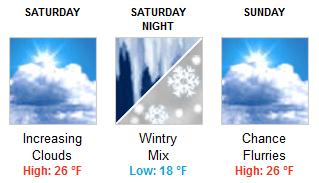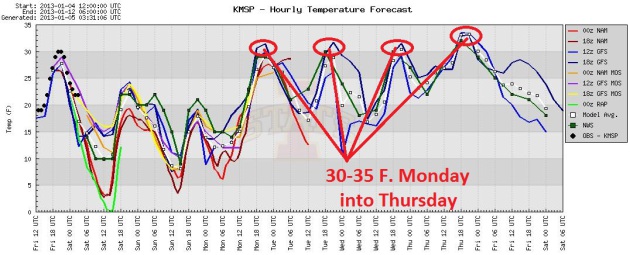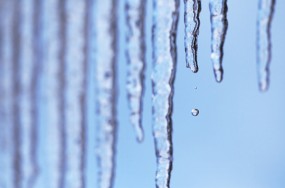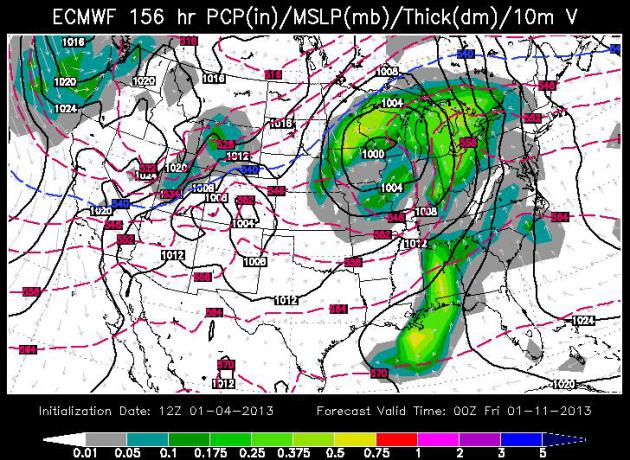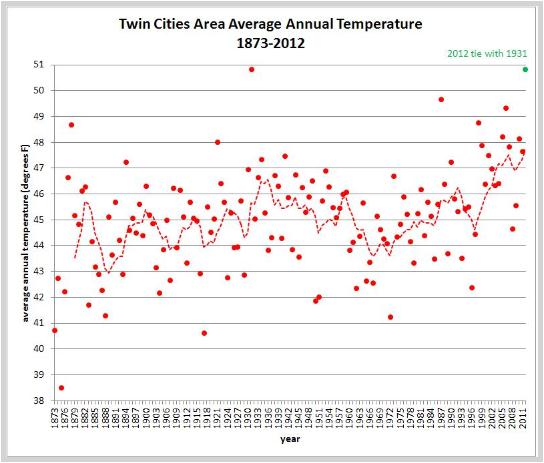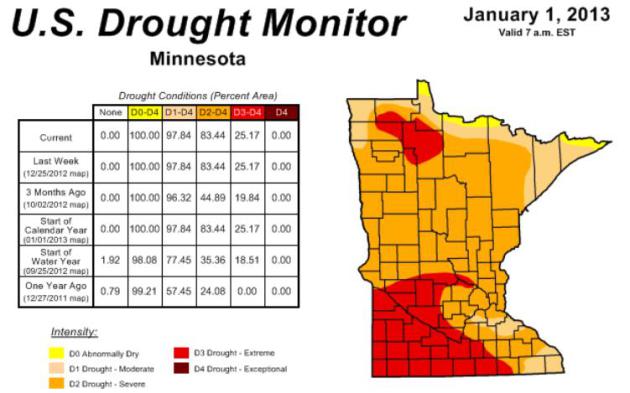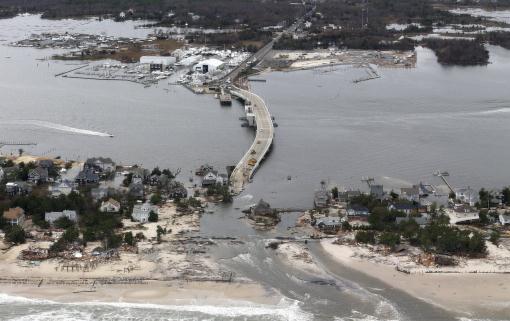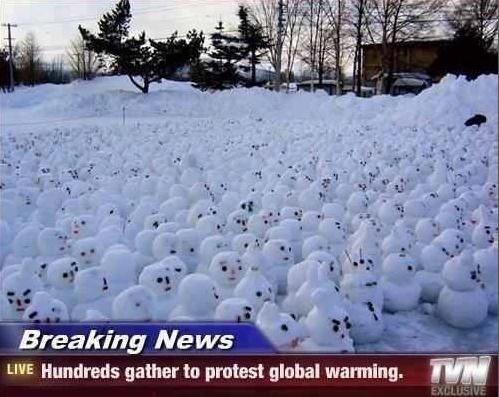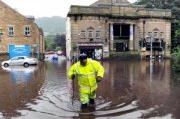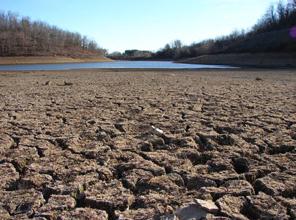Midwinter Pause
"I like these cold, gray winter days. Days like
these let you savor a bad mood" mused author Bill Watterson. Amen. And
here in the Land of Low Weather Expectations 32 degrees (in January) is
cause for noisy celebration. "Slush!" "Dripping icicles!" "I can feel my
extremities!" We cool off into the low 20s today and Sunday - the real
thaw kicks in starting Monday of next week.
The January Thaw is still something of a
meteorological mystery. For some reason temperatures often spike 2-3
weeks after the Winter Solstice, especially east of the Mississippi.
Temperatures thaw for a few days, before the coldest air of winter
rushes south a week or two later. According to Dr. Mark Seeley these
wondrous, if fleeting, thaws are more likely over southern Minnesota
than up north.
Expect low 20s at game time in Green Bay - risk
of a Purple Upset. We cool off this weekend before a 3-5 day spell at or
above freezing next week. A southern storm pushes a cold rain into town
next Thursday; a second disturbance may squeeze out some light snow on
Friday.
I still expect 2-3 nights below zero from January 15-18. Nothing we can't handle.
Check out the blog for more on the January Thaw, Minnesota's deepening drought & a 2012 weather recap.
Looking forward to tracking Adrian Peterson on Doppler.
* photo above courtesy of Tim Wright, who snapped this photo near Sauk Rapids.
Green Bay Weather. Perfect weather for a Vikings
victory. Will lightning strike twice, within the same week? The spread
is 8 points, but I'm thinking....upset. Stranger things have happened -
think positive. Weather should be a non-issue, a gametime temperature
around 20-22 F. with a wind chill in the mid teens. Balmy for GRB. A few
flurries are possible later tonight, maybe a dusting in Green Bay. More
details from
NOAA.
Predicted Highs Next Thursday. NOAA data shows highs
in the low to mid 30s across most of central and southern Minnesota by
next Thursday - fleeting hints of early March in the air.
Warming Trend. After a seasonably cool weekend (low
20s today and Sunday) the mercury rebounds next week, 4 days at or above
30 F. Right now Wednesday and Thursday look like the 2 mildest days;
low to mid 30s possible.
European Guidance. ECMWF data suggests mid-30s next
Wednesday, with a rain-snow mix possible next Thursday and Friday. Some
(slushy) accumulation can't be ruled out late next week; it's much too
early to even speculate about amounts.
More Data On The January Thaw. Dr. Mark Seeley has some insight into the (almost) annual upward blip in temperatures in his weekly
WeatherTalk Newsletter: "...
Most
residents of the Twin Cities area consider the January thaw to be a
given each year. They know it will come, just not precisely when.
This time around it looks like next Monday through Thursday (Jan 7-10)
may bring a thaw period. Indeed for many central and southern Minnesota
locations a January thaw is quite common. The definition of a January
thaw is variable. Some consider it to be any single day with a
temperature above 32 degrees F. But consequences associated with a
January thaw, like loss of snow cover, melting and drying of street
surfaces and sidewalks, softening of lake ice, etc are generally not
realized unless temperatures rise above the freezing mark for two or
more days. Using this as a sorting criteria we can look at the
historical frequency of such temperatures for various locations in
Minnesota. These frequencies of January thaws (listed below) indeed
show great reliability in most of southern Minnesota, and even parts of
central Minnesota, but more like a 50/50 probability in the northern
sections of the state..."
Weather Story. The local, Twin Cities office of the
National Weather Service provided the graphic above, showing Minnesota
in-between branches of the jet stream, a moist southerly river of
high-speed air guiding storms well south of Minnesota, the northern
branch blowing to our north, something of a quiet (Pacific) no-man's
land over the Upper Midwest.
Thursday Slop-Storm? It's still too early to get
specific, but the ECMWF model shows a moisture-laden southern storm
tracking just south/east of Minnesota toward the end of next week. A
rain-snow mix is possible over Minnesota, probably enough warm air aloft
to prevent widespread heavy snowfall over the Twin Cities. It's too
early to say with any confidence - parts of central and western
Minnesota may see accumulating snow on Thursday. Map above valid
Thursday evening courtesy of WSI.
Extended Outlook. I'm not buying the accumulating
snow next weekend, at least not yet. But the models have been fairly
consistent bringing another (brief) cold shot into Minnesota the third
week of January; maybe 2-3 nights below zero between January 15-18. GFS
guidance above.
An Icy Landscape. NASA's 250 meter resolution
MODIS imagery
shows the dark gray smudge of the Twin Cities metro. Flat, undeveloped
farmland shows up as bright white, as does Lake Minnetonka and the Inner
Lakes south of Minneapolis.
"Surreal Warmth" in 2012. Here's another 2:30 minute video recap on
YouTube, looking back at the extraordinary warmth of 2012, courtesy of WeatherNation TV.
Warm Year: 2012. Here's an excerpt of a great overview of record warmth across the great state of Minnesota last year - courtesy of the
Minnesota Climatology Working Group: "
2012
will finish in a tie with 1931 as the warmest year on record in the
Twin Cities and will range from the warmest to third warmest on record
depending on the location around the region. For so long, it appeared
like 2012 would be the warmest year on record for the Twin Cities, but
then winter decided to arrive as if on cue on December 21 and since
then temperatures have been mostly below normal. As a result, the
average temperature for the Twin Cities for 2012 will wind up to be
50.8 degrees, the same as the 50.8 degrees recorded in 1931. The
1981-2010 average temperature for the year is 46.3 degrees so 2012 will
finish 4.5 degrees above normal. Every month of 2012 was above normal
except October which finished 1.4 degrees below normal. March 2012 was
15.5 degrees above normal and greatly assisted in lifting the average
temperature for 2012. The hottest day of 2012 in the Twin Cities was 102
degrees on July 6 and the coldest temperature of the year was -11 on
January 19."
Twin Cities (1873-2012)
Rank Year Average
-----------------
1. 1931 50.8
2012 50.8
3. 1987 49.7
4. 2006 49.3
5. 1998 48.8
How Long Will Minnesota's Drought Linger? State Climatologist Greg Spoden adds some personal thoughts to his monthly
HydroClim summary: "
It
is reasonable to assume that the present drought status will remain
relatively unchanged for the remainder of the winter. The historical
average precipitation over the next two months is less than two inches
and the topsoil is sealed by frost. Therefore, Minnesota will be highly
dependent on spring rains to ease the situation. Without abundant
spring rains, a number of critical drought issues involving public water supply, agriculture, horticulture, tourism, and others will rapidly surface early in the growing season." (the latest Minnesota Drought Monitor information is
here).
Preliminary Data.
NOAA NCDC
data shows that January - November was the warmest on record for a big
chunk of the USA. Every region in bright red experienced the warmest
year in 118 years of record-keeping.
Region Chops Sandy Debris Down To Size. Here's an eye-opening clip from an article at
The Wall Street Journal: "
The
immense task of leveling the mountains of debris left behind by Sandy
is coming into focus two months after the historic superstorm ravaged
the East Coast. In the end, the federal government estimates that 16
million cubic yards of debris piled up around New York and New Jersey—enough to fill the Empire State Building 16 times over—though more than half has yet to arrive at landfills..."
Photo credit above: "
A aerial view of the damage in
Mantoloking, N.J., caused by Hurricane Sandy, Oct. 31, 2012. President
Barack Obama toured New Jersey's ravaged coastline with New Jersey Gov.
Chris Christie in a display of big-government muscle and bipartisan
harmony." (Doug Mills/The New York Times)
Climate Stories...
Facebook And The Rest Of Silicon Valley Could Be Wiped Out In 40 Years. Hype, or a real concern with rising sea levels? Here's an excerpt from a story at
Business Insider: "
While
much of California's coastline is at risk of rising sea levels, things
look particularly bad for the Bay Area. Silicon Valley is already 3-10
feet below sea level, and scientists say that seawater will rise 16
inches by 2050. By 2100, that number is supposed to jump to 65 inches,
and the entire area will experience more frequent, hard-hitting storms.
If the levees in place are destroyed or overwhelmed by a storm surge,
one hard blow could put the 3 million people who live in Silicon Valley
in a grisly Waterworld. "It's imminent," Mruz says. "There's no
question in my mind; we're going to have to do something, at every spot
around the Bay." Also at risk: Google, Yahoo, LinkedIn, Intel, Cisco, and Oracle.
"Silicon Valley basically backs right up to the bay," Mruz told CW.
"You have all of them, Yahoo, Google, all right there. Without some type
of flood protection potentially in front of that, you could flood that
whole area. You're talking billions of dollars..."
Scientists Link Global Warming To England's Rainiest Year On Record. This article at
euractiv.com caught my eye; here's an excerpt: "
Senior
climate scientists are linking global warming to the UK Met Office's
announcement yesterday (3 January) that 2012 was England’s rainiest
year since records began. The weather service's numbers showed that due
to slightly more seasonal figures in Wales and Scotland, the UK as a
whole experienced its second wettest summer recorded. But four of the
UK’s Top Five wettest years have now occurred since 2000, a statistic in line with the expectations of climatologists
who model the effects of a warming world. “It is not just Britain but
many other parts of northern Europe and north America that are getting
wetter and there is a climate change component to it,” Kevin Trenberth
told EurActiv over a phone line from the US National Center for
Atmospheric Research in Boulder, Colorado..."
Climate Change: What's Faith Got To Do With It? Here is an excerpt of an article that resonated with me, from California's
Whittier Daily News: "
Throughout
all of California and the rest of the country, the faith community has
been working for many years to preach the gospel of good stewardship
of our shared environment. Amid theological differences, we have
fostered a shared sense of purpose and urgency that unites us in
solidarity with our local and global communities, especially those most
vulnerable to climate change. The action that results from this shared
sense of purpose goes far beyond a congregation's four walls. People of
faith bring shared principles - such as working for the common good,
caring for our neighbors, and working for economic justice - into the
public policy arena..."
Global Warming And Drought In The Midwest: Expect More Of The Same? Here's a snippet of a story at
chicagomag.com: "
The
Midwest drought of 2012 has been one of the most expensive natural
disasters of recent decades, with Mississippi River barge traffic on the
verge of shutting down, and the Army Corps of Engineers blowing up underwater limestone to keep traffic moving:
‘If we were in the same conditions now, 30 years ago, we`d be running into problems much, much, sooner,’ Col. Hall said.
The rock removal does stop traffic for 16 hours every day. But the
Coast Guard, the river`s `traffic cop`, unclogs the jam overnight.
‘During the time that the Army Corps contractors are removing rock,
which is roughly 6:00am – 10:00pm at night, we gather up all the vessels
that are waiting north and south,’ Capt. Teschenford said. ‘They
actually do a quick survey of the area where rocks were removed and we
open it up. ‘

